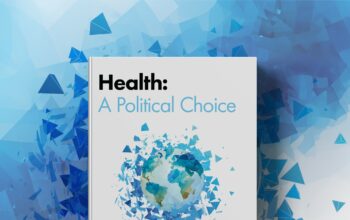Why we must remove barriers to trade to achieve vaccine equity (Step #3)
To put an end to the pandemic, industry was tasked with manufacturing and supplying billions of COVID-19 vaccines, starting from zero. This monumental task is on its way to being achieved, with 11 billion doses forecast for the end of 2021[1]—enough for the world’s adult population, according to the World Bank. However, trade restrictions, amongst other hurdles, are holding up both upstream and downstream supply, presenting a significant challenge to achieve vaccine equity.
The manufacture of 11 billion doses of COVID-19 vaccines by the end of 2021, along with the yearly production of 5 billion doses for other vaccines for diseases, represents a trebling of vaccine production within a year. Such scale impacts the availability of raw materials, skilled workers and vaccines supply. This increase in global traffic leads to significant and inevitable strain on the global vaccine manufacturing supply chain and any glitch or hold-up in the chain can set back efforts to optimize this vital scale up. A delay in a single ingredient can stall production, which in turn leads to delay in supply.
The WTO and its member states have recognized and acknowledged this bottleneck. Dr. Ngozi Okonjo-Iweala, Director-General of the World Trade Organization (WTO), recently noted that the number of trade restrictions related to medical supplies used against COVID-19 has risen to 53 trade restrictions in 2021 alone. This year has also seen trade restrictions on the distribution of vaccines. To address these concerns, a number of Member States have proposed a draft declaration on trade and health.[2]
To meet the unprecedented demand, industry has entered into more than 300 manufacturing deals, 220 of which involve technology transfer. Skilled workers are needed to transfer the technology and train manufacturers on quality and safety, and their availability is also severely impacted by trade restrictions. Despite the industry’s best efforts and robust contingency plans, these bottlenecks continue to disrupt production and supply of COVID-19 vaccines.
Therefore, as part of our Five Steps to achieve vaccine equity, we are calling on governments for trade restrictions to be eliminated for the uninterrupted movement of critical supplies, vaccines and skilled workers to produce enough COVID-19 doses for the world to end the pandemic.
Trade Interdependencies: Goods and Services
Vaccine production is highly complex, specialized and dependent on the global supply chain, with swift transit of goods, services and personnel.
The complexity of a single vaccine means scores of components are needed from suppliers across the globe. For example, the Johnson & Johnson vaccine contains 180 components manufactured at 67 sites in 12 countries; the Pfizer-BioNTech vaccine requires 280 components, relies on 86 suppliers located in 19 countries and is produced in just three manufacturing plants; the Moderna vaccine has a similar number.
Lipids are important for the delivery of mRNA vaccines, which, prior to the pandemic, were not required on such a scale. Different types of equipment are needed for vaccine production in manufacturing and storage, such as bioreactors and fridges/freezers. Other medical goods are required for manufacturing, packaging, storage and the administering of vaccines, such as vials, cold boxes, syringes, and needles. Currently, six critical input supplies are facing or likely to face shortages: bioreactor bags, single-use assemblies, filters, cell culture media, lipids, vials and stoppers.
To further complicate matters, no one manufacture or production line is the same as that of another vaccine. Airfinity, a life-science analytics company that provides real time information on vaccine production, has mapped 83 sites producing vaccine drug substances across the world[2], each with their own process.
Despite these challenges and this complexity, barriers to trade and tariffs on medical products are still imposed by many countries. One-fifth of countries have positive duties on vaccines, with 8% having a duty equal to or greater than 5%. Eliminating or reducing tariffs on medical goods and inputs will help expedite production.
Today, we run the risk of a single ingredient being held up at a border, leading to the halting of the entire manufacturing process. Restrictions on the upstream supply chain are leading to shortages of raw materials. Many of these essential components and those on the downstream supply chain are impacting distribution, resulting in doses being wasted and disposed of and prolonging the pandemic. This is something the world cannot afford.
Governments need to address and eliminate unnecessary supply chain barriers and export restrictions on both intermediate and final goods so we can get vaccines to people, curb excessive stockpiling and end this pandemic.
And where export restrictions are critical and need to be applied, they should be targeted, proportional, transparent and temporary. We echo the statement by Dr. Ngozi calling on the G20 leaders to “do more,” from donating more COVID-19 vaccines to removing trade restrictions that affect the vaccine supply chain.
Trade Interdependencies: Personnel
Given the complexity of the vaccine manufacturing process, a skilled workforce is the lifeblood of the process. If trained workers are not conducting quality checks and scientific equations, the raw materials being used will go to waste and production will have to restart.
A skilled workforce is also vital for successful technology transfer between vaccine makers. Not only are they involved in the production process, they also train the licensees to manufacture. Training for technology transfer is time intensive. It helps if the licensee can absorb the technology. For example, the Moderna facility in Switzerland (Lonza site) was unable to be up and running at an earlier date because the facility could not hire enough skilled workforce.
Needless to say, a skilled workforce is an invaluable component of the entire vaccine manufacturing process and is already stretched due to the pandemic. This workforce needs to be efficiently and effectively used. Today, the top 10 vaccine manufacturers have more than 5000 vacancies for skilled workers[3]. Prioritizing the movement of skilled workers across borders is crucial to ensure training for tech transfer takes place and large manufacturing plants have the required workforce to conduct quality and safety checks.
Vaccine Protectionism
The barriers to trade are further complicated when governments put policies in place to safeguard their own vaccine supplies for their population. These policies can lead to supplies being disposed of unused, while other countries are requesting that very supply—this needs to be revaluated. The measures also put unnecessary pressure on the supply chain, the impact of which has been acutely felt during the pandemic, as noted by World Health Organization (WHO) and WTO.
For example, the US employed export controls under the Defense Production Act (DPA) to prevent companies from exporting vaccine doses or ingredients without federal government authorisation. This decision was misguided and led to hurdles in production, as noted above. A similar restriction was placed by India, impacting supply to COVAX.
We have also seen national legislations restrict exports of raw materials. According to Airfinity, 39% of bioreactors suppliers and 37% of lipid suppliers are headquartered in the US. Legislation like the DPA controls the export of these raw materials, which leads to production lines being held up, impacting overall supply. This issue became so dire that it led to the CEO of the Serum Institute of India appealing to the US President on Twitter to lift the embargo on raw material exports out of the US, “if we are to truly unite in beating this virus.” Rajinder Suri, CEO of the Developing Countries Vaccine Manufacturers Network (DCVMN), stressed that the export restrictions have implications for the COVID-19 vaccine rollout across the world.
It was a welcome change in June this year when countries, including the US and EU Member States, agreed to dose sharing, and we hope that India can start exporting by October. Nevertheless, more can be done, as highlighted by WHO and WTO. Dr. Ngozi called for the G20 to donate at least two to three billion more doses to countries with high disease burdens.
Call to Action
There is growing recognition that the immediate needs of the biopharmaceutical and biotech industry to achieve vaccine equity are hampered by shortages of raw materials and restrictions on distrubution through export bans.
The WTO and its members have an important role to play to eliminate trade restrictions, to adopt policies that expedite the cross-border supply of inputs and finished vaccines, and to allow the movement of skilled workforce.
On 31 June 2021, 23 member states communicated a draft text for a Declaration on Trade and Health to be announced at the WTO Ministerial Conference in November. It includes reviewing and removing export restrictions with efforts to be made to remove or reduce tariffs.
These calls now need to become actions. Viruses ignore borders and supply chains are global. Only by removing trade restrictions and working together to streamline border processes do we stand a chance of ending the pandemic and achieving vaccine equity.
[1] Airfinity Presentation at WTO COVID-19 Vaccine Supply Chain and Regulatory Transparency Technical Symposium on 29 June 2021:
[2] https://docs.wto.org/dol2fe/Pages/SS/directdoc.aspx?filename=q:/Jobs/GC/251R3.pdf&Open=True
[3] https://www.wsj.com/articles/covid-19-vaccines-are-in-high-demand-but-thousands-more-workers-are-needed-to-make-them-11609764172
Author






